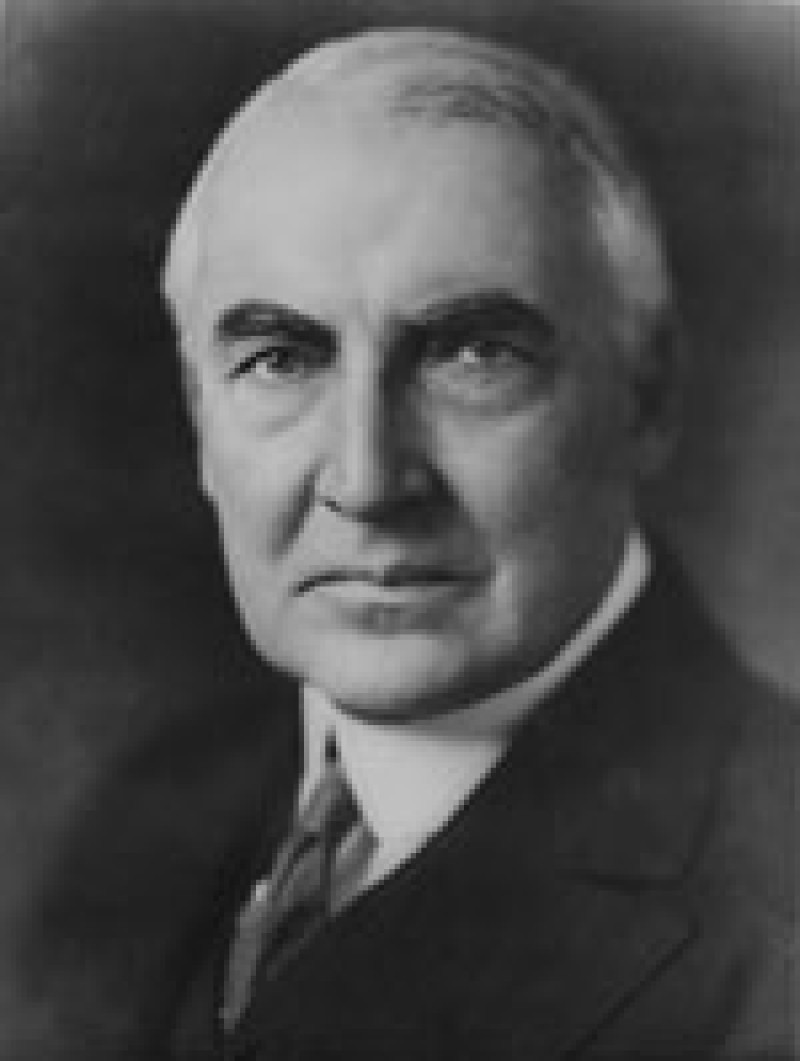Warren Gamaliel Harding (Nov. 2, 1865 - Aug. 2, 1923)
Warren Gamaliel Harding, 29th president of the United States, was born near Blooming Grove, Ohio. Harding attended Ohio Central College, a high school level institution in Iberia, for three years (1879-1882) and following graduation, moved with his parents to Marion.
By 1900 Harding had become one of Marion's leading and best-liked citizens. Genial, handsome, adept at small-town social life, and noted throughout central Ohio for his resonant speaking voice, he was prominent as a promoter of civic endeavors, a trustee of the Trinity Baptist Church, and a reliable fixture in the community's business and fraternal life. Editorship and community service also led naturally to politics, and in Harding's case to affiliation with the conservative Old Guard wing of the state Republican Party, especially with the political organization of Senator Joseph B. Foraker. With Foraker's support he was elected to the state Senate in 1899, served two terms there (1900-1904), and during the second term acted as floor leader for the Foraker group.
In 1903 Harding informally announced his candidacy for governor but finally agreed to accept a nomination for lieutenant governor on a ticket headed by Myron T. Herrick. In 1910, he was the party's compromise nominee for governor but was easily defeated by his Democratic opponent, Judson Harmon. Two years later he made the nominating speech for President William Howard Taft at the Republican National Convention and in the campaign that followed was an outspoken critic of Theodore Roosevelt and the Progressive Party.
In 1914, the first year in which U.S. senators were directly elected, Harding won the Republican nomination in a primary contest against his former sponsor, Joseph B. Foraker, and went on to defeat his Democratic opponent, Timothy Hogan.
In late 1919, Ohio political leader Harry M. Daugherty had opened a campaign on behalf of Harding, stressing in particular his record of party loyalty and regularity and his talents for conciliating conflicting factions. It was a sweeping victory for the Republicans, not so much on any one issue but in recoil against wartime controls, postwar disturbances and Wilsonian idealism. Harding easily defeated his Democratic opponent, James M. Cox.
Beyond generally conservative initiatives, the Harding administration made some gestures toward the progressive and managerial impulses flowing from prewar reform and wartime mobilization. It supported the Sheppard-Towner Act of 1921, providing federal subsidies for state programs of maternal and infant health care. It also urged the creation of a federal department of public welfare, the adoption of a child labor amendment, and enhanced political rights for southern blacks.
In foreign relations, Harding was guided by Secretary of State Charles Evans Hughes. The policies pursued were isolationist in the sense of rejecting membership in the League of Nations, negotiating separate peace treaties with Germany, Austria, and Hungary, and opposing any kind of ?entangling alliance.? The greatest diplomatic achievement of Harding's administration was the complex of treaties negotiated and signed at the Washington Conference on the Limitation of Armaments and on Far Eastern and Pacific Questions meeting in the winter of 1921-1922.
The darker side of Harding's administration was the growth of political corruption that eventually led to highly publicized scandals involving several different government offices. The most famous of the scandals, coming in subsequent years to symbolize the corruption of the period, involved the lease of naval oil reserves located at Teapot Dome in Wyoming and Elk Hills in California. How much Harding knew about the corruption in his administration has remained a matter of speculation.
In 1923, Harding suffered a coronary attack, bronchial pneumonia and a cerebral hemorrhage. He later died.
Recent revisionist scholarship has shown that contrary to myth Harding was a hardworking president who took his job seriously. Revisionists also argue that he deserves considerable credit for facilitating the nation's passage through a painful transitional period, for pacifying an angry and divided society and for stabilizing a disintegrating executive system.
Some content and graphic elements featured on webpages related to the Thomas J. Moyer Ohio Judicial Center were used with the permission of the Ohio Historical Society; the Prints and Photographs Division of the Library of Congress; the Office of the Curator of the Supreme Court of the United States and American National Biography Online.
Biography of Warren G. Harding (Nov. 2, 1865 - Aug. 2, 1923)
Citation: Ellis W. Hawley. "Harding, Warren Gamaliel"; http://www.anb.org/articles/05/05-00264.html; American National Biography Online Feb. 2000. Access Date: Fri Oct 3 09:54:35 2003. Copyright © 2000 American Council of Learned Societies. Published by Oxford Univeristy Press. All Rights Reserved.
Portrait of Warren G. Harding - Library of Congress, Prints & Photographs Division.

